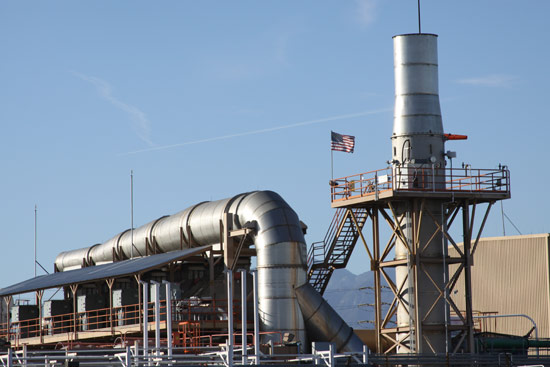WESP

Quemetco Invests in State of the Art Pollution Control Technology
In 2008, at a total investment exceeding $25,000,000, Quemetco installed a Wet Electrostatic Precipitator (“WESP”) at its facility to substantially reduce metallic particulate emissions such as lead and arsenic to the lowest levels achieved at any commercial secondary lead smelter in the world. WESPs are widely considered an excellent particulate removal devices and are considered an excellent control technology for target compounds such as arsenic and lead. Arsenic is greatly reduced in the scrubber section of the WESP, while other particulate metal compounds are removed in the WESP’s electrode collection section.
The South Coast Air Quality Management District (“SCAQMD”) established Rule 1420.1 to place limits on emissions of lead, arsenic, benzene, and 1,3-butadiene from large lead-acid battery recycling facilities. One of Rule 1420.1’s requirements is to maintain 30-day, rolling-average fence line ambient lead concentrations at or below 0.15 micrograms per cubic meter (µg/m3). This requirement has been reduced to 0.11 µg/m3 for 2016 and 0.10 µg/m3 for 2017 and beyond. Since installation of Quemetco’s WESP, testing required by the SCAQMD has verified substantial reductions in lead, arsenic, cadmium, nickel, and particulate emissions in Quemetco’s operations. Quemetco’s fence line monitoring stations verify that ambient concentrations are now well below the requirements of SCAQMD Rule 1420.1 and U.S. EPA National Ambient Air Quality Standards (NAAQS) and will be able to meet the stricter fence line ambient lead concentrations moving forward.
How Does the WESP Work?
Quemetco selected an “up flow” WESP design for its operations. With up flow design, inlet gas from the kiln, reverberatory furnace, electric arc furnace, and refinery flows through the primary particulate control equipment and then into the bottom of the WESP. Initial treatment is performed in the scrubber section at the lower part of the WESP, which contains a packed bed scrubber. In the scrubber section, SO2 is removed from the gas stream using low-concentration sodium carbonate solution as the scrubber liquid. For particulate metals control, the main purpose of the scrubber section is to ensure that the flow of inlet gas is saturated, cooled and evenly distributed as it moves to the collection section. A liquid cooling circuit, consisting of a cooling tower and a plate-and-frame heat exchanger, cools the gas and condenses the water vapor. A blow downstream is taken from the scrubber section recirculation line to remove sulfate reaction products and condensed water from the system. The blow down is used as make-up water for other scrubbing processes in the plant.
The initial treatment in the scrubber section offers a number of advantages. One is the collisions that occur between the water and the sub-micron particulate metals. This results in increased particle size and higher collection efficiencies in the WESP’s collection section. The gas volume is also reduced, allowing the collection section to be smaller than would otherwise be needed. Finally, gas cooling in the scrubber section ensures the greatest possible capture of condensable compounds such as arsenic from the gas stream prior to entering the collection section.
After passing through the scrubber section, the gas enters the collection section, which is comprised of an array of tubes containing a high-voltage electrode running through the center of each. Collection of particulate metals in this area involves three steps. Initially, the particles are given a negative charge by an ionizing corona produced by the electrode. Next, the electrical field between the electrode and the tube wall causes the charged particles to migrate to and accumulate on the tube walls. Finally, accumulated particulate is periodically washed from the tube walls into a basin at the bottom of the WESP. As the treated exhaust exits the collection section, it passes through a mist eliminator for water droplet removal prior to discharge through a stack.
Additional Pollution Controls
In addition to the WESP, the Quemetco facility employs other extensive emissions control equipment and technology, including bag houses, building ventilation units, a Regenerative Thermal Oxidizer (“RTO”), an ozone injection system for NOx control and scrubbers. Four bag houses and eleven building ventilation units equipped with multiple HEPA filters control particulate emissions from the furnaces, rotary kiln, and refinery processing areas, and keep the processing areas under negative pressure as required by Rule 1420.1.
Quemetco and its affiliates operate three battery-recycling facilities in the United States. After the WESP was installed and successfully operated at the Quemetco facility in California, the decision was made to install similar devices at the smelters located in Indiana and New York. The plant in Indiana now features an operating WESP and a WESP is under construction at the New York facility. These are the only lead facilities in the United States to install this technology; which is not required by any law or regulation. Quemetco is committed to continuous improvement and will continue its efforts to support regulations that would require every lead smelter to install the best technology available for reducing emissions.
about 10 million per year
Batteries Recycled
250 Full-time Union Workers
People employed
$100,000/year
Time, materials, and financial donations made to the community
120,000 tons/year
Recycled lead produced in tons
